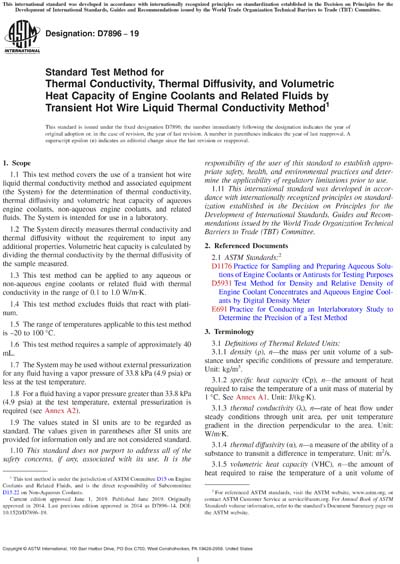Most recent
ASTM D7896-19
Standard Test Method for Thermal Conductivity, Thermal Diffusivity, and Volumetric Heat Capacity of Engine Coolants and Related Fluids by Transient Hot Wire Liquid Thermal Conductivity Method
1.1 This test method covers the use of a transient hot wire liquid thermal conductivity method and associated equipment (the System) for the determination of thermal conductivity, thermal diffusivity and volumetric heat capacity of aqueous engine coolants, non-aqueous engine coolants, and related fluids. The System is intended for use in a laboratory.
1.2 The System directly measures thermal conductivity and thermal diffusivity without the requirement to input any additional properties. Volumetric heat capacity is calculated by dividing the thermal conductivity by the thermal diffusivity of the sample measured.
1.3 This test method can be applied to any aqueous or non-aqueous engine coolants or related fluid with thermal conductivity in the range of 0.1 to 1.0 W/m∙K.
1.4 This test method excludes fluids that react with platinum.
1.5 The range of temperatures applicable to this test method is –20 to 100 °C.
1.6 This test method requires a sample of approximately 40 mL.
1.7 The System may be used without external pressurization for any fluid having a vapor pressure of 33.8 kPa (4.9 psia) or less at the test temperature.
1.8 For a fluid having a vapor pressure greater than 33.8 kPa (4.9 psia) at the test temperature, external pressurization is required (see Annex A2).
1.9 The values stated in SI units are to be regarded as standard. The values given in parentheses after SI units are provided for information only and are not considered standard.
1.10 This standard does not purport to address all of the safety concerns, if any, associated with its use. It is the responsibility of the user of this standard to establish appropriate safety, health, and environmental practices and determine the applicability of regulatory limitations prior to use.
1.11 This international standard was developed in accordance with internationally recognized principles on standardization established in the Decision on Principles for the Development of International Standards, Guides and Recommendations issued by the World Trade Organization Technical Barriers to Trade (TBT) Committee.
Content Provider
ASTM International [astm]






